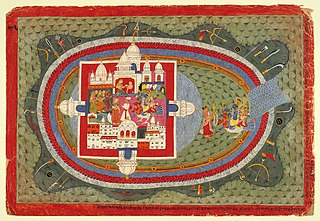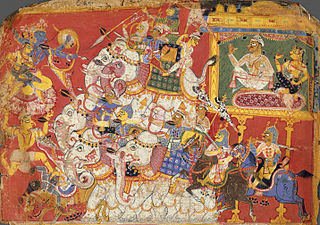Related Research Articles

Kamarupi Prakrit is the postulated Middle Indo-Aryan (MIA) Prakrit language used in ancient Kamarupa. This language has been derived from Gauda-Kamarupi Prakrit and the historical ancestor of the Kamatapuri lects and the modern Assamese language; and can be dated prior to 1250 CE, when the proto-Kamta language, the parent of the Kamatapuri lects, began to develop. Though not substantially proven, the existence of the language that predated the Kamatapuri lects and modern Assamese is widely believed to be descended from it.

The Kamakhya Temple at Nilachal hills in Guwahati, Assam is one of the oldest and most revered centres of Tantric practices, dedicated to the goddess Kamakhya. The temple is the center of the Kulachara Tantra Marga and the site of the Ambubachi Mela, an annual festival that celebrates the menstruation of the goddess. Structurally, the temple is dated to the 8th-9th century with many subsequent rebuildings—and the final hybrid architecture defines a local style called Nilachal. It is also one among the oldest 4 of the 51 pithas in the Shakta tradition. An obscure place of worship for much of history it became an important pilgrimage destination, especially for those from Bengal, in the 19th century during colonial rule.
Hindu law, as a historical term, refers to the code of laws applied to Hindus, Buddhists, Jains and Sikhs in British India. Hindu law, in modern scholarship, also refers to the legal theory, jurisprudence and philosophical reflections on the nature of law discovered in ancient and medieval era Indian texts. It is one of the oldest known jurisprudence theories in the world and began three thousand years ago whose original sources were the Hindu texts.

Shashanka was the first independent king of a unified polity in the Bengal region, called the Gauda Kingdom. He reigned in the 7th century, some historians place his rule between circa 600 CE and 636/7 CE, whereas other sources place his reign between 590 and 625 CE.

Khasas were an ancient Indo-Aryan tribe and a late Janapada kingdom from Himalayan regions of northern Indian subcontinent mentioned in the various historical Indian inscriptions and ancient Indian Hindu and Tibetan literature. European sources described the Khasa tribe living in the Northwest Himalayas and the Roman geographer Pliny The Elder specifically described them as "Indian people". They were reported to have lived around Gandhara, Trigarta and Madra Kingdom as per the Mahabharata.

Kamarupa, an early state during the Classical period on the Indian subcontinent, was the first historical kingdom of Assam.

The history of Assam is the history of a confluence of people from the east, west, south and the north; the confluence of the Austroasiatic, Tibeto-Burman (Sino-Tibetan), Tai and Indo-Aryan cultures. Although invaded over the centuries, it was never a vassal or a colony to an external power until the third Burmese invasion in 1821, and, subsequently, the British ingress into Assam in 1824 during the First Anglo-Burmese War.

The Kamata Kingdom emerged in western Kamarupa probably when Sandhya, a ruler of Kamarupanagara, moved his capital west to Kamatapur sometime after 1257 CE. Since it originated in the old seat of the Kamarupa kingdom, and since it covered most of the western parts of it, the kingdom is also sometimes called as Kamarupa-Kamata.

Pragjyotisha is a mythological kingdom that is mentioned in a multitude of Hindu epics. It came to be associated with the historical Kamarupa after Bhaskaravarman of the Varman dynasty by drawing his lineage from Naraka/Bhagadatta of the legendary Pragjyotisha to bring his peripheral kingdom closer to mainland traditions at a time when he was emerging as a powerful king with interests in North India. The identification with the mythical Naraka/Bhagadatta lineage continued to be used by the Mlechchhas and Palas for roughly similar purposes.

Biswa Singha (1515–1540) was the progenitor king of the Koch dynasty of the Kamata kingdom. He was able to unify different Bodo tribes, replace the Baro-Bhuyans of Kamata kingdom, and establish a dynasty the remnant of which still exists today.

The Baro-Bhuyans were confederacies of soldier-landowners in Assam and Bengal in the late Middle Ages and the early modern period. The confederacies consisted of loosely independent entities, each led by a warrior chief or a landlord. The tradition of Baro-Bhuyan is peculiar to both Assam and Bengal and differ from the tradition of Bhuinhar of Uttar Pradesh and Bihar—in Assam this phenomenon came into prominence in the 13th century when they resisted the invasion of Ghiyasuddin Iwaj Shah and in Bengal when they resisted Mughal rule in the 16th century.

The earliest Indo-Aryan migration to Assam is estimated to have occurred between the 2nd century BCE and 1st century CE—not earlier than 500 BCE. The earliest epigraphic record suggests that the Indo-Aryan migration began latest by the middle of the 4th century CE. They came from the Gangetic Plains into a region already inhabited by people who spoke Austroasiatic and Tibeto-Burman languages.
Kamrupi literature is the literature written in the modern Kamrupi dialects of Assamese language.

Kamrupi dialects are a group of regional dialects of Assamese, spoken in the Kamrup region. It formerly enjoyed prestige status. It is one of two western dialect groups of the Assamese language, the other being Goalpariya. Kamrupi is heterogeneous with three subdialects— Barpetia dialect, Nalbariya dialect and Palasbaria dialect.

The Janapadas were the realms, republics (ganapada) and kingdoms (sāmarājya) of the Vedic period in the Indian subcontinent. The Vedic period reaches from the late Bronze Age into the Iron Age: from about 1500 BCE to the 6th century BCE. With the rise of sixteen Mahajanapadas, most of the states were annexed by more powerful neighbours, although some remained independent.

Kamrup is the modern region situated between two rivers, the Manas and the Barnadi in Western Assam, with the same territorial extent as the Colonial and post-Colonial "Undivided Kamrup district". It was the capital region of two of the three dynasties of Kamarupa and Guwahati, the current political center of Assam, is situated here. It is characterized by its cultural artifacts.

KRNB lects are a cluster of modern lects that are phylogenetic descendants of the proto-Kamata language. The proto-Kamata language began differentiating after 1250 around Kamatapur, the capital city of Kamata kingdom, as the western branch of the proto-Kamarupa, whereas the eastern branch developed into proto-Assamese. Since the 16th century the proto-Kamta community has fragmented giving rise to the differentiated modern lects. The modern lects are: Kamta, Rangpuri (Bangladesh), Rajbanshi (Nepal) and Surjapuri (Bihar).

Vajradatta is an asura king in Hindu mythology. He is the son and successor of King Bhagadatta, and the third ruler of the Naraka dynasty of the Pragjyotisha Kingdom. Vajradatta is regarded to have studied the four Vedas along with the discplines called the Angas, as well as the Nitishastras of Brihaspati and Shukra. Vajradatta is mentioned in epics as powerful as Indra, speedy like Vajra and who pleased the performer of hundred sacrifices, who is Indra again, in battle. He said to possess bolt-like lustre and conquered enemies like Indra.
Assamese Brahmins are the Brahmins present in the Assamese society. There they promoted learning, Vedic religion, astrology, ayurveda and as well as imparting general vedic knowledge to the public. The Brahmins migrated to Assam from Videha (Mithila), Kannauj, Bengal and many other places.
The Kingdom of Laur was one of the many petty kingdoms of the Sylhet region. Others included the Gour Kingdom, Ita Kingdom, Taraf Kingdom, Pratapgarh Kingdom and Jaintia Kingdom.
References
- ↑ Samiti, Kamarupa Anusandhan (1985). Journal of the Assam Research Society - Volume 28. p. 97.
- ↑ Misra, Udayon (1991). Nation building and development in north east India. Centre for Rural and Industrial Development (Chandīgarh, India). p. 136.
- ↑ Vasu, Nagendra-nath (1926). The Social History Of Kamarupa Vol.2.